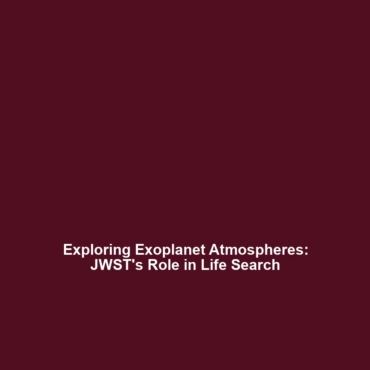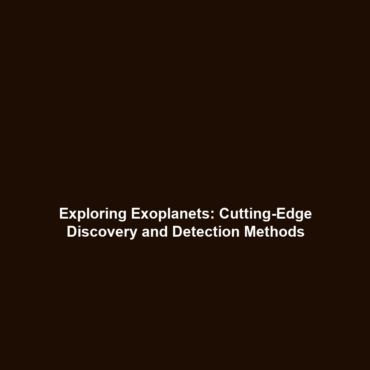<>
James Webb Space Telescope (JWST): How it Will Help in Studying Exoplanet Atmospheres and Search for Signs of Life
Introduction
The James Webb Space Telescope (JWST) represents a landmark advancement in astrophysical research, particularly in the study of exoplanets. Launched to replace the aging Hubble Space Telescope, JWST is equipped with sophisticated instruments designed to analyze the atmospheres of distant worlds and detect potential biosignatures. Its ability to peer into the depths of space allows scientists to comprehend the conditions and chemistry of exoplanet atmospheres while searching for signs of life—an endeavor that could transform our understanding of life beyond Earth.
Key Concepts
Overview of Exoplanet Studies
Exoplanets, or planets outside our solar system, have become a focal point of astronomical research. The JWST enhances our capability to:
- Conduct spectroscopy of exoplanet atmospheres.
- Identify water vapor, carbon dioxide, and methane signatures.
- Analyze the thermal properties of these distant worlds.
How JWST Fits into Exoplanet Research
JWST complements existing telescopes by offering:
- Infrared observations that facilitate the study of cooler environments.
- A larger mirror for increased light-gathering capabilities.
- Advanced instruments capable of high-resolution imaging.
Applications and Real-World Uses
The applications of JWST in exoplanet research are extensive. Key uses include:
- How JWST is used in exoplanet atmospheres: By studying transmitted light during transits, JWST can uncover atmospheric compositions.
- Applications of JWST in the search for life: Analyzing gases in exoplanet atmospheres can hint at biological processes.
- Monitoring changes in exoplanet atmospheres over time.
Current Challenges
Despite its capabilities, JWST faces several challenges, including:
- Challenges of JWST: The sheer distance of targets makes data collection complex.
- Issues in exoplanet studies: Atmospheric contamination during observations may skew results.
- The need for collaborative data interpretation across diverse scientific disciplines.
Future Research and Innovations
Looking ahead, the James Webb Space Telescope is poised to drive numerous innovations in exoplanet research. Upcoming developments may include:
- Next-gen {technology} that improves the precision of atmospheric analysis.
- Collaborations with other observatories to gather comprehensive datasets.
- Breakthroughs in AI technologies for enhanced data processing and interpretation.
Conclusion
The James Webb Space Telescope is set to revolutionize how scientists study exoplanet atmospheres and search for signs of life. Through its advanced capabilities, JWST not only broadens our understanding of these planets but also ignites hope in the search for extraterrestrial life. To stay updated on the latest research and findings, explore our related topics on Exoplanet Research or follow the developments in Life Beyond Earth.

